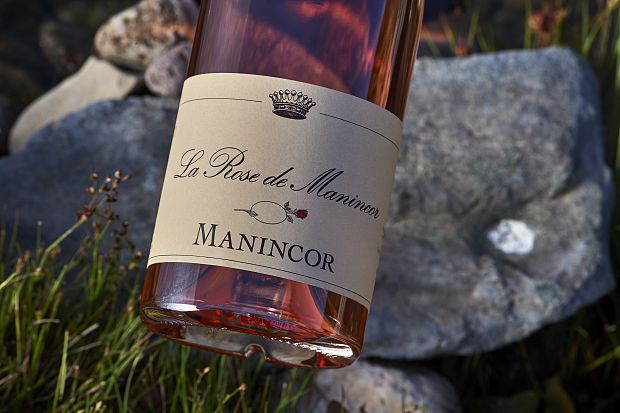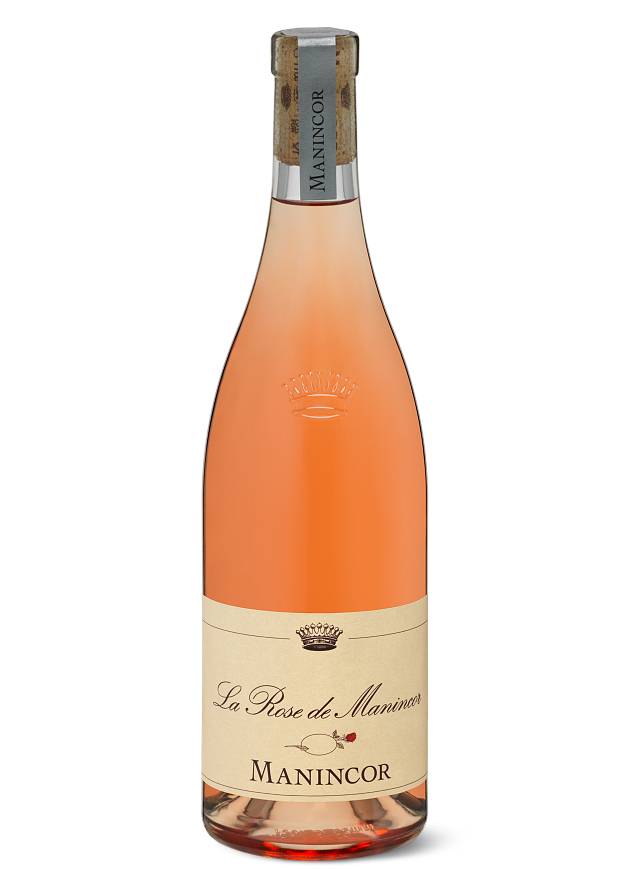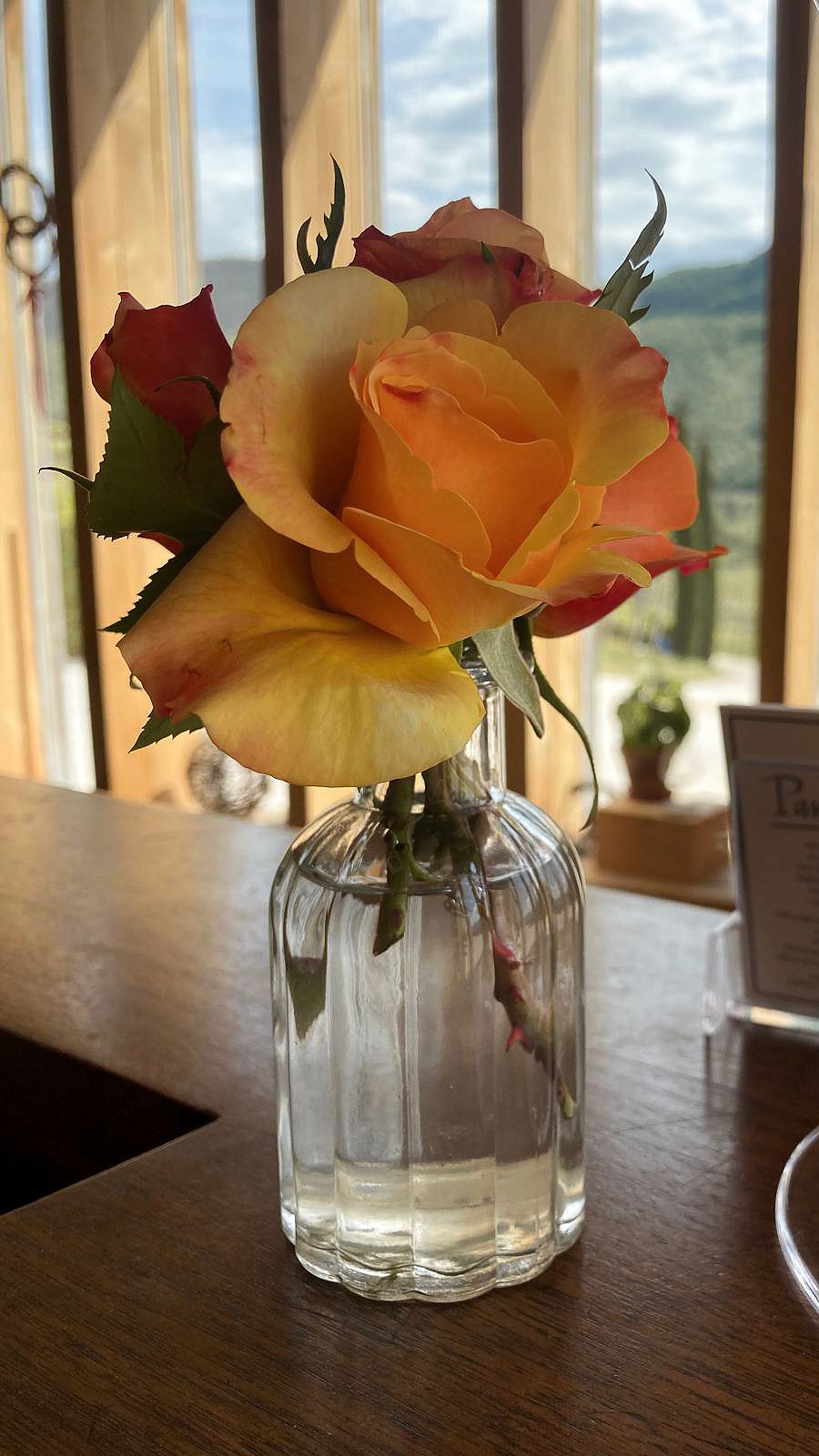La Rose
The pleasure of enjoying wines in gardens.
With the help of La Rose de Manincor

Some wines make you want to open a door, to step beyond the four walls that sometimes offer warmth and protection and sometimes threaten confinement. They are a call for you to go outside, onto the balcony or verandah or perhaps – what luxury! – into the garden. Sometimes it is enough to open a window and let in the fresh air – and admit the world.
La Rose de Manincor is just such a wine. It awakens memories of the open spaces from which this cuvée originates. In it, without any exaggeration, there is more of Manincor than in any other wine from the estate. All seven of its red grape varieties are to be found in La Rose: Merlot, Cabernet Franc, Petit Verdot, Syrah, Tempranillo, Pinot Noir and Cabernet Sauvignon. It also contains (almost) all the Manincor red wines: Mason di Mason, Mason, Castel Campan, Cassiano and Rubatsch. Ten percent of the juice is racked off from the must after just a few hours of contact with the skins. That is so short a period that only little skin colorant is extracted from the grapes, which explains the clear light red color of a rosé that is also refreshing at first sight. The the bleed-off juice is then vinified separately, vineyard by vineyard, undergoing spontaneous fermentation in 500-liter oak barrels.
Shortly before Christmas it is time to assemble the cuvée by blending the wines from the various barrels. Sometimes fermentation may not yet have been completed in one of the barrels and not all the sugar will have been converted into alcohol. That explains the few grammes of residual sugar that give La Rose de Manincor its distinctive creamy softness. But it is never more than three or four grammes per liter so as not to detract from the finesse and delicacy of the wine’s refreshing acidity.
It is probably this freshness that is behind La Rose’s polite insistence on being enjoyed in the open air. To some extent this characteristic is reflected in the name: The wine is not simply called Rosé but La Rose, i.e. The Rose. And roses are always at their most beautiful, no matter how seductive a bouquet of roses can be, where they grow – in the garden.

There is a special form of garden that is devoted to these fine plants: the rose garden or rosarium. Many of them house collections of roses from all over the world – a sign of the great esteem in which these wonderful flowers are held. Since time immemorial they have been a symbol of love, joy in life and youthfulness but also – beware of the thorns! – of pain. Not surprisingly, they were dedicated to the gods and goddesses of love and beauty, from Isis and Aphrodite, Eros and Dionysos to Venus. They were equally at home in the gardens of Mesopotamia and China, India and Egypt – and also in Greece, of course, which is where the word comes from: from the name of the island of Rhodes, where the rose was revered in ancient times. Roses played an important role in the gardens of the Romans and in those of medieval monasteries. There the enclosed “garden of paradise” (hortus conclusus) was a symbol of the Immaculate Conception of the Virgin Mary. For Christians, there is more symbolism in the rose: It is an expression of the eternal life that comes after death – one of the central tenets of Christianity based on the resurrection of God incarnate.
From the Renaissance gardens of Italy with their often incredible water features, whose beauty evaporates anew each day, and the splendiferous Baroque gardens of France, in which Nature herself is harnessed to the decorative yoke, to the English gardens as a concession to the fact that success can never be guaranteed in man’s fight with the elements – there can be few specimens in which roses are completely absent. They occupy a firm place in the history of western garden architecture, which is about more than man’s fortuitous invention of the garden on his causal quest for a bit of peace and quiet; it speaks in fundamental terms of the relationship between man and nature, of gentle dreams and deep-seated anxieties, of unrestrained fantasies of human hegemony, and of a vain longing for the eternal world of the remote imagination in the here and now – the anticipation of paradise on Earth. That unfortunately is doomed to come to an abrupt end: Outside the gates of the ideal, vulnerable artistic garden lurk danger and chaos in the form of the untamed forces of rampant nature.
Vineyards lie somewhere between these ideal artificial worlds of nature on the one hand and the kitchen garden enclosed to keep out the hungry animals on the other. (The English word “garden” comes from the Indo-European “ghordo” meaning “a fenced-off plot of land”. The Latin “hortus”, French “jardin”, German “Garten”, Italian “giardino” and Slav “gorod” all have the same etymology.) The vineyards differ from the open fields and meadows in that they are enclosed (in South Tyrol at least, although elsewhere that is rarely the case) and from the gardens of paradise (where sloth is the order of the day) in that they mean work.

It is here – the reader will perhaps have guessed already – that the argument comes full circle: Roses are not infrequently to be found in the vineyards of South Tyrol – and in those on the Manincor estate, of course. They play a highly useful role as indicator plants. For example, they are the first to show signs of mildew attack, which can do serious damage to the vines. Some people would even go as far as to say that roses in the vineyard ward of pests and disease. Be that as it may, they are a beautiful sight among the vines. In spite of all the hard work to be done in the vineyard, the “queen of flowers”, as the Greek poetess Sappho called the rose in the sixth century B.C., reminds us of the uplifting power of at least some human dreams (and what would life be without them?). More than any other cultivated plant in our world, roses in the garden reflect the eternal magic of beauty and the irrevocable transience of all life on Earth (just think of the melancholy emanating from faded rose petals lying on the ground …), and their presence here and there among the vines transforms every vineyard into a little paradise.
That brings us back again to La Rose and its invitation to enjoy the fresh air. And by the way, serious wine drinker’s guide includes the tip (which is sometimes more of an admonition) that certain wines should be drunk outdoors. In his excellent book “Reading between the Wines”, the American wine dealer and writer Terry Theise does so on several occasions (not forgetting the added charm of birdsong), as did Belá Hamvas in his wonderful “Philosophy of Wine”: “In summer I drink in the garden, under the trees, or on the verandah ....”
So let us take their advice here and now – with a glass of La Rose de Manincor! Strawberries, plums and herb blossoms – in its aromas are gathered all the fruits of the garden. And perhaps the name – in combination with a delicate shade of salmon pink – will even conjure up an intimation of the scent of rose blossom. Every year La Rose is always a little bit different: sometimes slightly firmer and refreshingly crystalline and sometimes fuller and almost opulent in the front of the mouth. But whatever the final result, it is always a pleasure to enjoy this wonderful rosé in the open air. And if there is no garden in the vicinity, no wine bar can be so confined that a sip of La Rose (if you are attentive enough) does not remind you of certain forms of naturalness and freedom (perhaps existential abandon is the word) that can only be felt outdoors – where the play of life unfolds each year with all its ups and downs, embedded in the ultimately unfathomable interaction of the elements. “The Rose is without why,” as Angelus Silesius (1624–1677) put it in his fine poem, which continues: “She blooms because she blooms / she does not care for herself / Asks not if she is seen.” The importance of appreciating that – that is also something we can and should be reminded of when we enjoy a glass of La Rose de Manincor.
